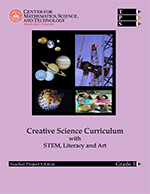Third Grade Science
Book Info

Make It Solid
This lesson focuses on the changes that take place when water changes from a liquid to a solid. They measure the expansion and express it as a fraction. They apply the concept by using water to break plaster or concrete.
Crank It Up
It is impossible to address forces, motion, and energy without doing mathematics. As soon as things move, the questions arise "how far?" or "how fast?" The challenge lies in how to combine required science concepts with appropriate mathematics. This lesson introduces mechanical energy. Students make a crane using a plastic cup and a pencil. They then measure the weight of two objects using a simple scale and compare the force required to lift them with their fingers to using the crane to lift them. Students will see that although the weight is the same, the amount of force required is much less if the crane is used. The crane is, however, much slower. There are two additional activities included (Explore It 3 and 4) in the teacher edition that are not printed in the student edition. These activities allow the student to measure and calculate mechanical advantage. Simple machines and mechanical advantage are not 3rd grade science concepts. The mathematics necessary to calculate MA, however, is appropriate at this grade level if students are allowed to use a calculator. In Explore It 4, students calculate work and power. Here again, the mathematics is appropriate, but the science concepts go beyond what is required. Omitting these additional activities will not adversely affect attainment of the educational standards. There are some spaces for students to record information in the Student Project Edition, but you might prefer for them to record data, and draw sketches in a journal.
Just Swimmingly
In this lesson, students learn about form and function, habitats, and life cycles by designing and building a fish using a plastic bottle. They research various characteristics of fish and design theirs according to what they see. They may, however, decide to deviate from nature, perhaps with disastrous results. Students will describe the ideal habitat for their fish including food and life cycle.
Game Day
The educational standard indicates that students are to collect weather data. In this lesson, weather conditions are connected to professional sports teams. The data is used to make an argument, either for or against that team building an indoor facility.
Spinning in Space
After completing this lesson, students will have a fairly good idea of the motion of the Earth, moon, and Sun. Students will build a model of the solar system and then use it to discover several concepts. Students will see how the earth rotates producing day and night, how the moon revolves around the earth and the revolution of the earth around the sun. They will also see how the tilt of the earth's axis produces seasons and how the movement of the moon produces phases. Of course, any model has its limitations. The main problem is that of scale. If the sun was actually the size of a basketball, the earth would be much smaller than a pea and about 90 feet from the basketball. Obviously, these dimensions cannot be realistically represented in a classroom.
Making Mountains
Just like the solar system, models of the earth are difficult to make. The real thing is just too large to accurately depict in the classroom. In this activity, a peanut butter and jelly sandwich will be used to represent the earth's crust. Yes, there is the potential of peanut allergies. Any sandwich spread can be used. Students will apply forces to the sandwich to make various landforms. In the next activity, students explore the movement of tectonic plates using cardboard and marbles. Finally, this knowledge of plates and layers is applied as they prospect for valuable natural resources buried deep inside their sandwich.
Summer Sun
In this lesson, students will make a sundial and record shadows for 1 day. They will then tape the sundial to a globe to determine how the earth rotates and the tilt of the axis. Later in the lesson they will place thermometers on the globe to see how the tilt of the axis affects climate at different latitudes.
Human Body 101
Students will be building a human body in this lesson. They will use cotton swaps for bones and modeling clay for internal organs and muscles. Encourage the use of the proper terms. Knowing the difference between the tibia and fibula are not part of the educational standards at this level, if you use the proper terms, they will also.
Happy Flowers
Students will design and conduct experiments to determine what conditions are favorable for plant growth. This will include exploration of soil, light, and water. In the process, students will learn the structure and function of plants.